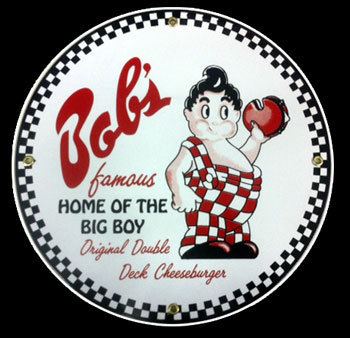Founder Bob Wian | ||
 | ||
Founded 1936, Southern California, California, United States Similar Johnie's Broiler, Johnie's Coffee Shop, Downtown Burbank, Martial Arts History Museum, Burbank Town Center | ||
Bob s big boy the original restaurant
Bob's Big Boy is a restaurant chain that Bob Wian founded in Southern California in 1936, originally named Bob's Pantry. It is now part of Big Boy Restaurants International, the current primary trademark owner and franchisor of the Big Boy system.
Contents
- Bob s big boy the original restaurant
- Short history of the chain
- Oldest remaining restaurant
- Other notable locations
- References
Wian created his famous Big Boy hamburger, just less than a year of opening his original location by slicing a bun into three slices and adding two hamburger patties.
Short history of the chain
According to a 2013 Los Angeles Times article, Bob Wian started the 10-stool Bob's Pantry hamburger stand at 900 E. Colorado in Glendale in 1936. This stand expanded adding carhop service until it was finally demolished and replaced by a McAllister designed drive-in in 1956. This location was known as "Bob's #1" and remained as a Bob's until it was closed and demolished in 1989. A second Glendale location at Broadway and Maryland was known as "Bob's #4", while the Toluca Lake location was known as "Bob's #6". Wian sold the chain to Marriott in 1967.
Oldest remaining restaurant
The Bob's Big Boy Restaurant located at 4211 Riverside Drive in Burbank, California, is the oldest remaining Bob's Big Boy in the United States. Built in 1949 by local residents Scott MacDonald and Ward Albert, it was designed by noted Los Angeles architect Wayne McAllister, "incorporating the 1940s transitional design of streamline moderne style, while anticipating the freeform 1950s coffee shop architecture. The towering Bob's sign is an integral part of the building design and its most prominent feature." The building is said to have "made McAllister's reputation," and he is credited with creating the restaurant's circular drive-through design.
The restaurant was designated a California Point of Historical Interest in 1993. McAllister worked to preserve the structure as a historic landmark. McAllister was also the architect for the original Lawry's restaurant on La Cienega Boulevard in Beverly Hills, and the original Sands Hotel casino and Desert Inn casino in Las Vegas. He designed some 40 coffee shops in the Los Angeles area in the late 1940s, and each with a distinctive look. Creative coffee shop designs started in Los Angeles because of the popularity of automobiles, and then spread across the nation.
The design of the Toluca Lake Bob's represents a distinct period in the region's architectural history, a style often referred to as Googie architecture. The building features a curving windowed facade and expansive roof overhangs with 1950s "free-form" style of cantilevered roofs and tall display signs.
The Riverside Drive Bob's Big Boy was designed as a drive-in, in which carhops brought food to the cars, and now operates a drive-thru window. In 1993, the tower sign was renovated, the dining room updated and an outdoor dining area added. Carhop service was reintroduced on weekends and a weekly classic car show is hosted in the parking lot.
Bob Hope and other movie personalities such as Mickey Rooney, Debbie Reynolds, Jonathan Winters, Dana Andrews, Martha Raye, Alexis Smith and Craig Stevens, were once regulars at the restaurant. Hope frequented the Burbank drive-in because it afforded him privacy.
Famed British musical group The Beatles dined at the Burbank location during their 1965 U.S. Tour. The table is the last booth on the right as one walks in, where the end of the windows facing out towards Riverside Drive's stop. For many years a plaque described the event; the plaque has been stolen many times by fans, and has been replaced each time. Many regulars to the restaurant call this table and booth "The Beatles Booth."
